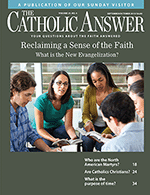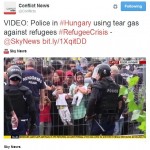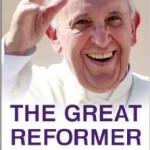 In Catholic circles, everyone talks about “The New Evangelization”, but explaining what exactly it is, is not always easy. In my column in this issue of The Catholic Answer Magazine, I more or less “go to the sources” to help give solid examples of The New Evangelization, in Theory and Application:
In Catholic circles, everyone talks about “The New Evangelization”, but explaining what exactly it is, is not always easy. In my column in this issue of The Catholic Answer Magazine, I more or less “go to the sources” to help give solid examples of The New Evangelization, in Theory and Application:
Weeks before his death in 2005, Pope John Paul still appeared at his apartment window and, unable to speak, showed his faithful attention to the people and received theirs in return. His mere presence and mindfulness was a silent rebuke to a world being carried off by a culture of death; it was an eloquent statement that even when old and less-abled, the human person has both purpose and value beyond immediate understanding, all of it rooted in hope.
Pope Benedict XVI, introverted and shy, but dogged and dutiful in his lifelong service to the Church, was the professorial “teaching pope” whose every action and statement boiled down — in one way or another — to the power that resides in trust, which animates the fire of faith. To have faith in God is to trust in His love — to trust that He wants only our good, even when life seems to be handing us something bad. So important is trust to the life of faith, and so important is the Eucharistic faith to the life of the world, that Pope Benedict — realizing that trust in the Roman road was damaged and in need of repair — helped build new roads for rites of Christian unity. Most incredibly, when he realized that the world had stopped paying attention, this good teacher gave us one last, astonishing and profound lesson in what it means to have faith: he cast the whole Church (and therefore the world) into the path of the Holy Spirit in a supreme act of humility, and he trusted. Whether he had faith in the papal conclave is unknowable; his faith in Providence is unquestionable.
And what was delivered to the world through that act? A pope who took all of the theory of faith and hope, through 2,000 years, and showed us what its application looks like: it looks like you and like me. It looks like a casual greeting and an impromptu remark full of encouragement. It looks like the placing of flowers before a holy image, and sweetly familial prayer…
You can read the rest, here. As the last graf demonstrates, The New Evangelization is something so very basic that it is easy to miss.
UPDATE:
In her weekly column, Peggy Noonan wrote of these three popes:
There’s a quality in certain popes so that when you see them go by in the popemobile, or just on a TV screen, your soul sort of jumps and you find yourself moved in a way you can’t explain. John Paul II was like that—I remember a businessman, a casual Protestant, turning to me once when the pope was on TV and saying: “I can’t figure it out but every time I see him my eyes fill up.”
. . .it wasn’t true of Benedict, who followed him, but it is true of Francis.
When you think about it, that’s not at all surprising. Hope and charity are both dynamic and dramatic — they both are extroverted in outreach. Faith is quiescent. It is an in-reach; the vertical part of the cross that balances hope and love.
UPDATE:
Pat Archbold, reactionary, has 10 Quotes that prove the Pope is a “Liberal!”.












